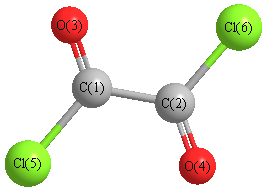Geometric Data

Point Group C2h
Internal coordinates
distances (r) in Å, angles (a) in degrees, dihedrals (d) in degrees
| Description |
Value |
unc. |
Connectivity |
Reference |
Comment |
| Atom 1 |
Atom 2 |
Atom 3 |
Atom 4 |
| rCO |
1.182 |
0.002 |
1 |
3 |
|
|
1998Kuc |
|
| rCC |
1.534 |
0.005 |
1 |
2 |
|
|
1998Kuc |
|
| rCCl |
1.744 |
0.002 |
1 |
5 |
|
|
1998Kuc |
|
| aCCO |
124.2 |
0.3 |
2 |
1 |
3 |
|
1998Kuc |
|
| aCCCl |
111.7 |
0.2 |
1 |
2 |
6 |
|
1998Kuc |
|
Cartesians
| Atom |
x (Å) |
y (Å) |
z (Å) |
| C1 |
-0.1691 |
0.7481 |
0.0000 |
| C2 |
0.1691 |
-0.7481 |
0.0000 |
| O3 |
-1.2692 |
1.1806 |
0.0000 |
| O4 |
1.2692 |
-1.1806 |
0.0000 |
| Cl5 |
1.2692 |
1.7344 |
0.0000 |
| Cl6 |
-1.2692 |
-1.7344 |
0.0000 |
Atom - Atom Distances 
Distances in Å
| |
C1 |
C2 |
O3 |
O4 |
Cl5 |
Cl6 |
| C1 |
|
1.5340 | 1.1820 | 2.4060 | 1.7440 | 2.7153 |
| C2 |
1.5340 |
|
2.4060 | 1.1820 | 2.7153 | 1.7440 |
| O3 |
1.1820 | 2.4060 |
|
3.4667 | 2.5981 | 2.9150 |
| O4 |
2.4060 | 1.1820 | 3.4667 |
|
2.9150 | 2.5981 |
| Cl5 |
1.7440 | 2.7153 | 2.5981 | 2.9150 |
|
4.2984 |
| Cl6 |
2.7153 | 1.7440 | 2.9150 | 2.5981 | 4.2984 |
|
Calculated geometries
for ClCOClCO (Oxalyl chloride).
Experimental Bond Angles (degrees) from cartesians 
| atom1 |
atom2 |
atom3 |
angle |
|
atom1 |
atom2 |
atom3 |
angle |
| C1 |
C2 |
O4 |
124.200 |
|
C1 |
C2 |
Cl6 |
111.700 |
| C2 |
C1 |
O3 |
124.200 |
|
C2 |
C1 |
Cl5 |
111.700 |
| O3 |
C1 |
Cl5 |
124.100 |
|
O4 |
C2 |
Cl6 |
124.100 |
Bond descriptions
Examples: C-C single bond, C=C, double bond, C#C triple bond, C:C aromatic bond
| Bond Type |
Count |
| C-C |
1 |
| C=O |
2 |
| C-Cl |
2 |
Connectivity
| Atom 1 |
Atom 2 |
| C1 |
C2 |
| C1 |
O3 |
| C1 |
Cl5 |
| C2 |
O4 |
| C2 |
Cl6 |
Dipole, Quadrupole and Polarizability
Electric dipole moment 
| State |
Config |
State description |
Conf description |
Exp. min. |
Dipole (Debye) |
Reference |
comment |
Point Group |
Components |
| x |
y |
z |
total |
dipole |
quadrupole |
| 1 |
1 |
1AG |
C2h |
True |
|
|
|
|
|
|
C2h |
0 |
3 |
Experimental dipole measurement abbreviations: MW microwave; DT Dielectric with Temperature variation; DR Indirect (usually an upper limit); MB Molecular beam
Calculated electric dipole moments for
ClCOClCO (Oxalyl chloride).
Electric quadrupole moment 
| State |
Config |
State description |
Conf description |
Exp. min. |
Quadrupole (D Å) |
Reference |
comment |
Point Group |
Components |
| xx |
yy |
zz |
dipole |
quadrupole |
| 1 |
1 |
1AG |
C2h |
True |
|
|
|
|
|
C2h |
0 |
3 |
Calculated electric quadrupole moments for
ClCOClCO (Oxalyl chloride).








